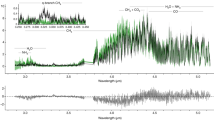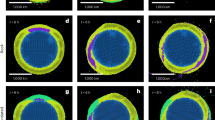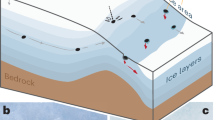Abstract
Carbonaceous asteroids represent the principal source of water in the inner Solar System and might correspond to the main contributors for the delivery of water to Earth. Hydrogen isotopes in water-bearing primitive meteorites, for example carbonaceous chondrites, constitute a unique tool for deciphering the sources of water reservoirs at the time of asteroid formation. However, fine-scale isotopic measurements are required to unravel the effects of parent-body processes on the pre-accretion isotopic distributions. Here, we report in situ micrometre-scale analyses of hydrogen isotopes in six CM-type carbonaceous chondrites, revealing a dominant deuterium-poor water component (δD = −350 ± 40‰) mixed with deuterium-rich organic matter. We suggest that this deuterium-poor water corresponds to a ubiquitous water reservoir in the inner protoplanetary disk. A deuterium-rich water signature has been preserved in the least altered part of the Paris chondrite (δDParis ≥ −69 ± 163‰) in hydrated phases possibly present in the CM rock before alteration. The presence of the deuterium-enriched water signature in Paris might indicate that transfers of ice from the outer to the inner Solar System were significant within the first million years of the history of the Solar System.
This is a preview of subscription content, access via your institution
Access options
Access Nature and 54 other Nature Portfolio journals
Get Nature+, our best-value online-access subscription
$29.99 / 30 days
cancel any time
Subscribe to this journal
Receive 12 digital issues and online access to articles
$119.00 per year
only $9.92 per issue
Buy this article
- Purchase on Springer Link
- Instant access to full article PDF
Prices may be subject to local taxes which are calculated during checkout



Similar content being viewed by others
References
Marty, B. et al. Origins of volatile elements (H, C, N, noble gases) on Earth and Mars in light of recent results from the ROSETTA cometary mission. Earth Planet. Sci. Lett. 441, 91–102 (2016).
Oba, Y. & Naraoka, H. Elemental and isotope behavior of macromolecular organic matter from CM chondrites during hydrous pyrolysis. Meteorit. Planet. Sci. 44, 943–953 (2009).
Alexander, C. M. O. ’D. et al. Deuterium enrichments in chondritic macromolecular material—implications for the origin and evolution of organics, water and asteroids. Geochim. Cosmochim. Acta 74, 4417–4437 (2010).
Remusat, L., Guan, Y., Wang, Y. & Eiler, J. M. Accretion and preservation of D-rich organic particles in carbonaceous chondrites: evidence for important transport in the early Solar System nebula. Astrophys. J 713, 1048–1058 (2010).
Gounelle, M. et al. Hydrogen isotopic composition of water from fossil micrometeorites in howardites. Geochim. Cosmochim. Acta 69, 3431–3443 (2005).
Rubin, A. E., Trigo-Rodríguez, J. M., Huber, H. & Wasson, J. T. Progressive aqueous alteration of CM carbonaceous chondrites. Geochim. Cosmochim. Acta 71, 2361–2382 (2007).
Hewins, R. H. et al. The Paris meteorite, the least altered CM chondrite so far. Geochim. Cosmochim. Acta 124, 190–222 (2014).
Marrocchi, Y., Gounelle, M., Blanchard, I., Caste, F. & Kearsley, A. T. The Paris CM chondrite: secondary minerals and asteroidal processing. Meteorit. Planet. Sci 49, 1232–1249 (2014).
Robert, F. & Epstein, S. The concentration and isotopic composition of hydrogen, carbon and nitrogen in carbonaceous meteorites. Geochim. Cosmochim. Acta 46, 81–95 (1982).
Alexander, C. M. O. ’D., Fogel, M., Yabuta, H. & Cody, G. D. The origin and evolution of chondrites recorded in the elemental and isotopic compositions of their macromolecular organic matter. Geochim. Cosmochim. Acta 71, 4380–4403 (2007).
Alexander, C. M. O. ’D. et al. The provenances of asteroids, and their contributions to the volatile inventories of the terrestrial planets. Science 337, 721–723 (2012).
Remusat, L. Organics in primitive meteorites. Planet. Mineral 15, 33–65 (2015).
Le Guillou, C., Bernard, S., Brearley, A. J. & Remusat, L. Evolution of organic matter in Orgueil, Murchison and Renazzo during parent body aqueous alteration: in situ investigations. Geochim. Cosmochim. Acta 131, 368–392 (2014).
Deloule, E. & Robert, F. Interstellar water in meteorites? Geochim. Cosmochim. Acta 59, 4695–4706 (1995).
Bonal, L. et al. Hydrogen isotopic composition of the water in CR chondrites. Geochim. Cosmochim. Acta 106, 111–133 (2013).
Piani, L., Robert, F. & Remusat, L. Micron-scale D/H heterogeneity in chondrite matrices: a signature of the pristine solar system water? Earth Planet. Sci. Lett. 415, 154–164 (2015).
Ceccarelli, C. et al. in Protostars and Planets VI (eds Beuther, H. et al.) 859–882 (University of Arizona Press, Tucson, 2014).
Vacher, L. G., Marrocchi, Y., Verdier-Paoletti, M. J., Villeneuve, J. & Gounelle, M. Inward radial mixing of interstellar water ices in the solar protoplanetary disk. Astrophys. J 827, L1 (2016); erratum 836, L16 (2017).
Howard, K. T., Benedix, G. K., Bland, P. A. & Cressey, G. Modal mineralogy of CM chondrites by X-ray diffraction (PSD-XRD): part 2. Degree, nature and settings of aqueous alteration. Geochim. Cosmochim. Acta 75, 2735–2751 (2011).
Le Guillou, C. & Brearley, A. Relationships between organics, water and early stages of aqueous alteration in the pristine CR3.0 chondrite MET 00426. Geochim. Cosmochim. Acta 131, 344–367 (2014).
Méheut, M., Lazzeri, M., Balan, E. & Mauri, F. First-principles calculation of H/D isotopic fractionation between hydrous minerals and water. Geochim. Cosmochim. Acta 74, 3874–3882 (2010).
Eiler, J. M. & Kitchen, N. Hydrogen isotope evidence for the origin and evolution of the carbonaceous chondrites. Geochim. Cosmochim. Acta 68, 1395–1411 (2004).
Robert, F. Water and organic matter D/H ratios in the solar system: a record of an early irradiation of the nebula? Planet. Space Sci. 50, 1227–1234 (2002).
Clayton, R. N. & Mayeda, T. K. Oxygen isotope studies of carbonaceous chondrites. Geochim. Cosmochim. Acta 63, 2089–2104 (1999).
Browning, L. B., McSween, H. Y. & Zolensky, M. E. Correlated alteration effects in CM carbonaceous chondrites. Geochim. Cosmochim. Acta 60, 2621–2633 (1996).
Leroux, H., Cuvillier, P., Zanda, B. & Hewins, R. H. GEMS-like material in the matrix of the Paris meteorite and the early stages of alteration of CM chondrites. Geochim. Cosmochim. Acta 170, 247–265 (2015).
Horstmann, M. et al. Tracking aqueous alteration of CM chondrites—insights from in situ oxygen isotope measurements of calcite. 45th Lunar Planet. Sci. Conf. 1761 (2014).
Haack, H. et al. Maribo—a new CM fall from Denmark. Meteorit. Planet. Sci. 47, 30–50 (2012).
Lee, M. R., Sofe, M. R., Lindgren, P., Starkey, N. A. & Franchi, I. A. The oxygen isotope evolution of parent body aqueous solutions as recorded by multiple carbonate generations in the Lonewolf Nunataks 94101 CM2 carbonaceous chondrite. Geochim. Cosmochim. Acta 121, 452–466 (2013).
Deloule, E., Robert, F. & Doukhan, J. Interstellar hydroxyl in meteoritic chondrules: implications for the origin of water in the inner solar system. Geochim. Cosmochim. Acta 62, 3367–3378 (1998).
Stephant, A., Remusat, L. & Robert, F. Water in type I chondrules of Paris CM chondrite. Geochim. Cosmochim. Acta 199, 75–90 (2017).
van Kooten, E. M. M. E. et al. A divergent heritage for complex organics in Isheyevo lithic clasts. Geochim. Cosmochim. Acta 205, 119–148 (2017).
Engrand, C., Deloule, E., Robert, F., Maurette, M. & Kurat, G. Extraterrestrial water in micrometeorites and cosmic spherules from Antarctica: an ion microprobe study. Meteorit. Planet. Sci. 34, 773–786 (1999).
Aléon, J., Engrand, C., Robert‡, F. & Chaussidon, M. Clues to the origin of interplanetary dust particles from the isotopic study of their hydrogen-bearing phases. Geochim. Cosmochim. Acta 65, 4399–4412 (2001).
Sarafian, A. R., Nielsen, S. G., Marschall, H. R., McCubbin, F. M. & Monteleone, B. D. Early accretion of water in the inner solar system from a carbonaceous chondrite-like source. Science 346, 623–626 (2014).
Sarafian, A. R. et al. Early accretion of water and volatile elements to the inner Solar System: evidence from angrites. Phil. Trans. R. Soc. A 375, 20160209 (2017).
Jacquet, E. & Robert, F. Water transport in protoplanetary disks and the hydrogen isotopic composition of chondrites. Icarus 223, 722–732 (2013).
Yang, L., Ciesla, F. J. & Alexander, C. M. O. ’D. The D/H ratio of water in the solar nebula during its formation and evolution. Icarus 226, 256–267 (2013).
Richet, P., Bottinga, Y. & Javoy, M. A review of hydrogen, carbon, nitrogen, oxygen, sulphur, and chlorine stable isotope fractionation among gaseous molecules. Annu. Rev. Earth Planet. Sci. 5, 65–110 (1977).
Drouart, A., Dubrulle, B., Gautier, D. & Robert, F. Structure and transport in the solar nebula from constraints on deuterium enrichment and giant planets formation. Icarus 140, 129–155 (1999).
Geiss, J. & Gloeckler, G. Isotopic composition of the H, He and Ne in the protosolar cloud. Space Sci. Rev. 106, 3–18 (2003).
Lécluse, C. & Robert, F. Hydrogen isotope exchange reaction rates: origin of water in the inner solar system. Geochim. Cosmochim. Acta 58, 2927–2939 (1994).
Lunine, J. I. in Meteorites and the Early Solar System II (eds Lauretta, D. S. & McSween Jr, H. Y.) 309–319 (University of Arizona Press, Tucson, 2006).
Ciesla, F. J., Lauretta, D. S., Cohen, B. A. & Hood, L. L. A nebular origin for chondritic fine-grained phyllosilicates. Science 299, 549–552 (2003).
Yamamoto, D. & Tachibana, S. A kinetic study on hydrous mineral formation reaction between amorphous forsterite and water vapor in protoplanetary disks. 47th Lunar Planet. Sci. Conf. 1733 (2016).
Yurimoto, H. & Kuramoto, K. Molecular cloud origin for the oxygen isotope heterogeneity in the Solar System. Science 305, 1763–1766 (2004).
Gehre, M. et al. On-line hydrogen-isotope measurements of organic samples using elemental chromium: an extension for high temperature elemental-analyzer techniques. Anal. Chem. 87, 5198–5205 (2015).
Vinogradoff, V. et al. Paris vs. Murchison: impact of hydrothermal alteration on organic matter in CM chondrites. Geochim. Cosmochim. Acta 212, 234–252 (2017).
Yoneda, S. et al. Sayama meteorite: a new CM chondrite fall in Japan with highly aqueously altered textures. 32nd Lunar Planet. Sci. Conf. 2034 (2001).
Takaoka, N. et al. Sayama CM2 chondrite: fresh but heavily altered. 32nd Lunar Planet. Sci. Conf. 1645 (2001).
Martins, Z., Modica, P., Zanda, B. & d’Hendecourt, L. L. S. The amino acid and hydrocarbon contents of the Paris meteorite: insights into the most primitive CM chondrite. Meteorit. Planet. Sci. 50, 926–943 (2015).
Piani, L., Remusat, L. & Robert, F. Determination of the H isotopic composition of individual components in fine-scale mixtures of organic matter and phyllosilicates with the nanoscale secondary ion mass spectrometry. Anal. Chem. 84, 10199–10206 (2012).
Alexander, C. M. O. ’D., Bowden, R., Fogel, M. L. & Howard, K. T. Carbonate abundances and isotopic compositions in chondrites. Meteorit. Planet. Sci. 50, 810–833 (2015).
Williford, K. H. et al. Carbon and sulfur isotopic signatures of ancient life and environment at the microbial scale: Neoarchean shales and carbonates. Geobiology 14, 105–128 (2016).
Remusat, L., Piani, L. & Bernard, S. Thermal recalcitrance of the organic D-rich component of ordinary chondrites. Earth Planet. Sci. Lett. 435, 36–44 (2016).
Verdier-Paoletti, M. J. et al. Oxygen isotope constraints on the alteration temperatures of CM chondrites. Earth Planet. Sci. Lett. 458, 273–281 (2017).
Pizzarello, S., Feng, X., Epstein, S. & Cronin, J. R. Isotopic analyses of nitrogenous compounds from the Murchison meteorite: ammonia, amines, amino acids, and polar hydrocarbons. Geochim. Cosmochim. Acta 58, 5579–5587 (1994).
Chokai, J. et al. Aqueous alteration mineralogy in CM carbonaceous chondrites. 35th Lunar Planet. Sci. Conf. 1506 (2004).
Rubin, A. E. An American on Paris: extent of aqueous alteration of a CM chondrite and the petrography of its refractory and amoeboid olivine inclusions. Meteorit. Planet. Sci. 50, 1595–1612 (2015).
Acknowledgements
The authors are grateful to the French National Museum of Natural History (Paris) and B. Zanda for providing the pieces of the Paris chondrite, to F. Robert for providing the samples of Murchison, Murray and Mighei, to the Japanese Museum of Natural History and S. Yoneda for providing the Sayama sample, and to V. Vinogradoff for providing some of the insoluble organic matter isolated from Paris. H. Naraoka from the Planetary Trace Organic Compounds research center is thanked for the measurement of the whole-rock H2O content and D/H ratio of Sayama. F. Baudin from the French Institut des Sciences de la Terre (ISTeP, UPMC−Université Paris 06) is thanked for the measurement of the bulk carbon content of Paris. N. Kawasaki, Y. Marrocchi, B. Marty, N. Sakamoto, I. Sugawara, S. Tachibana and A. Williams are warmly thanked for fruitful discussions and for providing assistance that allowed this work to be completed. This work was supported by the grant-in-aid for Scientific Research on Innovative Areas “Evolution of molecules in space from interstellar clouds to proto-planetary nebulae” supported by the Ministry of Education, Culture, Sports, Science & Technology, Japan (grant number 50754595, L.P.). This is CRPG contribution #2562.
Author information
Authors and Affiliations
Contributions
L.P. designed the study, analysed the samples and wrote the paper. L.R. and H.Y. were involved in the study design and interpretation of the data and also provided input to the manuscript.
Corresponding author
Ethics declarations
Competing interests
The authors declare no competing interests.
Additional information
Publisher’s note: Springer Nature remains neutral with regard to jurisdictional claims in published maps and institutional affiliations.
Supplementary information
Supplementary Information
Supplementary Tables 1–2, Supplementary Figures 1–4
Rights and permissions
About this article
Cite this article
Piani, L., Yurimoto, H. & Remusat, L. A dual origin for water in carbonaceous asteroids revealed by CM chondrites. Nat Astron 2, 317–323 (2018). https://doi.org/10.1038/s41550-018-0413-4
Received:
Accepted:
Published:
Issue Date:
DOI: https://doi.org/10.1038/s41550-018-0413-4
This article is cited by
-
Organic matter and water from asteroid Itokawa
Scientific Reports (2021)
-
Extraterrestrial hexamethylenetetramine in meteorites—a precursor of prebiotic chemistry in the inner solar system
Nature Communications (2020)
-
Migration of D-type asteroids from the outer Solar System inferred from carbonate in meteorites
Nature Astronomy (2019)
-
Accretion of Water in Carbonaceous Chondrites: Current Evidence and Implications for the Delivery of Water to Early Earth
Space Science Reviews (2019)



